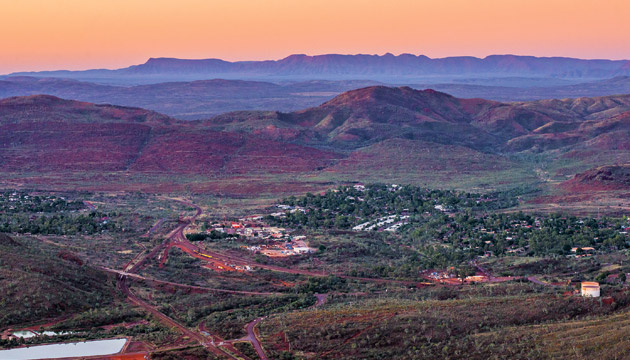After 50 years, iron ore remains king in Tom Price, although there is much more to this good-looking Pilbara town than mining.
Story Terri Cowley Photo Eleanor Lukale
Sonia and Hayden Powell have lived in their fair share of West Australian mining towns, so when they say Tom Price is special, you had better believe it. They’ve lived in the red-dirt Pilbara town for 13 years. “It is a very transient town, so to be here 13 years, people say, ‘Whoa’,” Sonia says. “I have finally brought out my white linen – now it has a pink tinge to it. I am finally feeling settled.”
Nestled in the Hamersley Range at the base of accessible Mt Nameless, well-serviced and nicely maintained Tom Price is known as Western Australia’s top town, because at over 740 metres above sea level it is the highest in the state.
Sonia works for community-resource centre Nintirri, including being event manager for the annual Karijini Experience. Karijini National Park provides a spectacular backdrop, with visitors stopping in or staying on the way to its amazing gorges, swimming holes and waterfalls.
Hayden is a driller at Rio Tinto’s Mount Tom Price Mine, about 20 minutes’ drive south of town. The open-pit iron-ore mine began in 1966 – the first of the company’s operations in the Pilbara, and one of 15 today.
Locals had long believed there was iron ore here and in 1961 Rio Tinto and local pastoralists Lang Hancock and Peter Wright were each granted 10 temporary reserves of 130 square kilometres. According to the book People, Prospects and Persistence: A History of Rio Tinto Exploration, high-grade finds began almost immediately. The following year, geologists were flying back to camp when they spotted a large dark outcrop of blue-black ore. This – the site of today’s mine – turned out to be one of the richest iron-ore discoveries ever, containing 66 percent iron. Current production (including the nearby Western Turner Syncline mine) is more than 30 million tonnes per annum.
The deposit was named after Thomas Moore Price, an American expert who convinced the West Australian Government to listen to Rio Tinto and realise the abundance of iron ore in the state. Originally you had to be a Rio Tinto employee to live in town, but now private rentals of company-built houses are available. Of the population of just under 3000 people, about half work in the mine.
Comparing Tom Price to Leonora, Laverton and Meekathara – the other mining towns he and Sonia have lived in – Hayden says, “Tom Price is the winner so far – this is as good as it gets. Everything is good about it, but it’s mainly the roster. Three day shifts; three night shifts; then six beautiful days off.” Working days are long, starting at 5.30am and ending close to 7pm. “That’s mining; I’m used to it,” Hayden says. “Hardly worth turning up for an eight-hour day.”
This story excerpt is from Issue #115
Outback Magazine: October/November 2017










